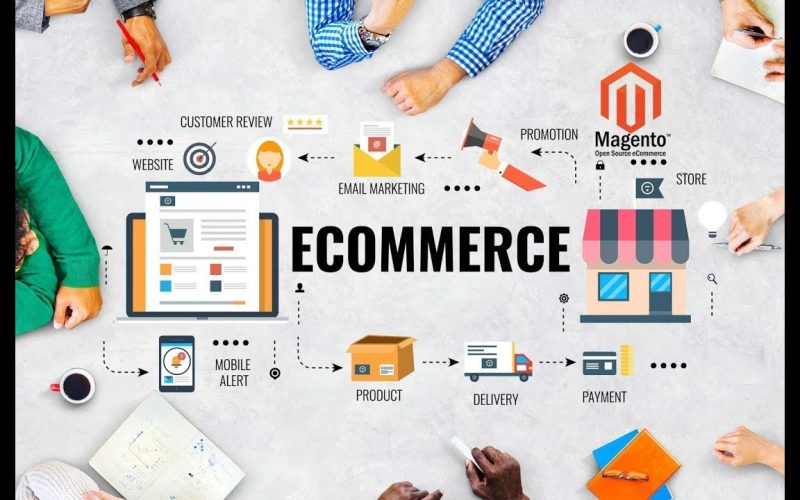Introduction
In a world where digital commerce is evolving rapidly, having a robust and scalable online store is no longer a luxury it’s a necessity. As one of the industry’s most trusted and customizable platforms, Magento has emerged as a top choice for businesses that demand robust functionality and total control over their online shopping experience. Whether you’re a small retailer looking to expand or a large enterprise managing multiple storefronts, Magento provides the tools you need to succeed.
In this comprehensive guide, we’ll explore everything you need to know about Magento eCommerce website development from platform features to implementation strategy, and why it remains a favourite among serious eCommerce players.
Why Choose Magento for eCommerce?
Magento, now owned by Adobe, is an open-source platform that powers thousands of online stores worldwide. It is designed for businesses that require a high level of customization, scalability, and performance.
Key Benefits of Magento:
- Customizability: Full control over functionality, design, and user experience.
- Scalability: Capable of supporting thousands of products and high traffic loads.
- Multi-store Management: Manage multiple storefronts from one admin dashboard.
- SEO-Friendly: Built-in SEO tools to optimize visibility in search engines.
- Large Community & Marketplace: Thousands of extensions and themes for added functionality.
Magento offers a free, open-source version and a premium edition (Adobe Commerce), including cloud hosting and enterprise-level features.
Magento Open Source vs. Adobe Commerce
Before starting development, it’s crucial to understand the two main editions of Magento:
1. Magento Open Source
- Cost: Free to use
- Hosting: Self-hosted (you choose your provider)
- Best For: Startups, small to medium-sized businesses
- Features: Product management, order tracking, payment and shipping integration, etc.
2. Adobe Commerce (formerly Magento Enterprise)
- Cost: Paid (based on revenue tier)
- Hosting: Includes cloud hosting and support
- Best For: Medium to large enterprises
- Features: Enhanced security, performance monitoring, advanced analytics, AI-driven product recommendations, and B2B tools
The right choice depends on your business goals, budget, and technical capabilities.
Planning Your Magento eCommerce Website
Developing a Magento website starts with a solid plan. This helps avoid costly mistakes and ensures the final product meets your business needs and user expectations.
Steps in the Planning Phase:
- Define Objectives: What do you want your website to achieve—brand visibility, high conversions, global reach?
- Analyze Your Audience: Understand user behaviour, preferences, and buying patterns.
- Map Features & Functionality: Determine your must-have features, such as multi-language support, advanced search filters, loyalty programs, etc.
- Decide on Hosting Requirements: Magento requires a high-performance hosting environment. Look for providers that specialize in Magento hosting.
- Create a Timeline & Budget: Set realistic expectations to guide development.
Design & Development Process
Magento allows you to build a beautiful and functional store. Whether you choose a ready-made theme or go entirely custom, your store’s design must reflect your brand and prioritize user experience.
1. UI/UX Design
- Custom Themes: For unique branding and layout flexibility
- Responsive Design: Ensure optimal performance on mobile and desktop
- Customer-Centric Layouts: Prioritize ease of navigation, product discovery, and fast checkout
2. Core Development
During this phase, developers configure Magento’s core functionality, including:
- Product catalogue structure
- Payment gateways
- Shipping methods
- Tax rules
- CMS pages (About, Contact, FAQ)
Custom modules and third-party extensions may also be integrated to enhance capabilities.
3. Integration with Third-Party Services
Magento supports seamless integration with:
- ERP systems
- CRM tools
- Marketing platforms
- Payment processors
- Shipping carriers
These integrations streamline operations and create a unified experience across business functions.
Performance Optimization and Security
Magento is powerful but needs proper optimization to perform at its best. Poorly optimized Magento sites can be slow and prone to errors.
1. Performance Best Practices:
- Use full-page caching (Varnish or Redis)
- Optimize images and media files
- Minify CSS, JavaScript, and HTML
- Leverage Content Delivery Networks (CDNs)
2. Security Measures:
- Implement two-factor authentication
- Use secure admin paths and strong passwords
- Regularly update core files and extensions
- Install security patches promptly
Adobe Commerce also includes built-in security tools for enterprises, including PCI compliance and dedicated support.
Testing & Quality Assurance
A flawless user experience depends on rigorous testing. Before the site goes live, every feature and integration must be verified.
Testing Checklist:
- Functional Testing: Check all user-facing functions—login, cart, checkout, search, etc.
- Cross-Browser Testing: Ensure compatibility across Chrome, Firefox, Safari, and others
- Mobile Responsiveness: Test on various screen sizes and devices
- Load Testing: Simulate heavy traffic conditions to identify performance bottlenecks
- Security Testing: Scan for vulnerabilities, data leaks, and compliance risks
Once testing is complete, your Magento store is ready for deployment.
Post-Launch Support & Maintenance
Launching your Magento store is just the beginning. Ongoing maintenance ensures smooth performance, security, and the ability to adapt to changing user expectations.
Post-Launch Tasks:
- Monitor traffic and conversions with analytics tools
- Regularly update themes, extensions, and core files
- Optimize SEO and content for better search visibility
- Address customer feedback for continuous improvement
- Plan for scalability as traffic and orders grow
Why Work With Certified Magento Developers?
Magento is a highly technical platform. Working with certified Magento developers ensures your store is built using best practices, secure coding standards, and optimized performance techniques.
Certified Developers Bring:
- In-depth knowledge of Magento architecture
- Experience with custom module development
- Faster turnaround times
- Reduced risk of bugs and errors
- Ongoing support and upgrades
Certified experts are essential to success if your project includes custom features, complex integrations, or extensive product catalogues.
Conclusion
Magento eCommerce website development offers unmatched flexibility, control, and scalability. From product management to marketing automation, Magento empowers businesses to create digital shopping experiences that convert and grow. However, realizing its full potential requires strategic planning, skilled development, and ongoing optimization.
Whether you’re a retailer just starting or a large business seeking a robust enterprise-grade solution, Magento can support your growth—if implemented correctly. With the right development partner and a clear roadmap, your Magento-powered store can become a dynamic engine of online success.
Need expert help with your Magento project? Partner with certified Magento professionals to build, optimize, and scale your online store.












